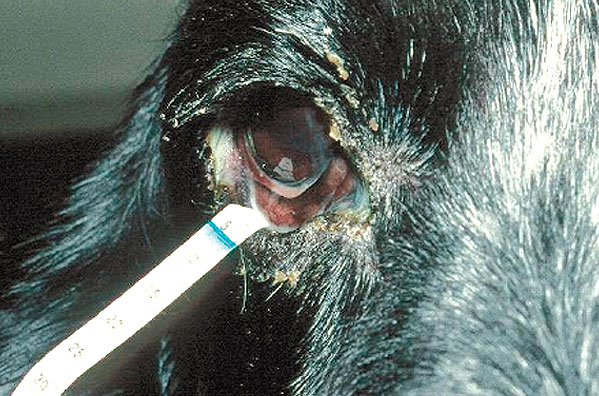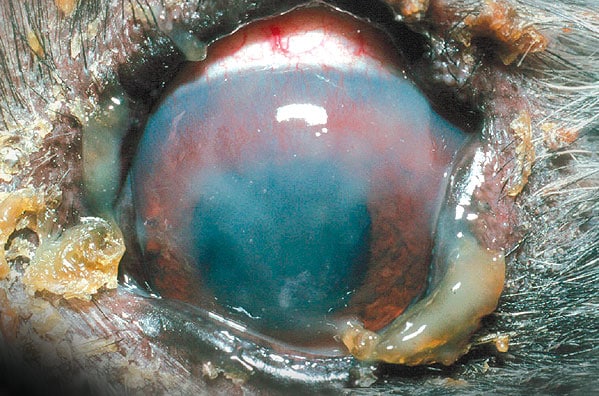
What is dry eye?
Dry eye is a term used to describe a poor tear production. Tears are essential for the maintenance of a healthy eye. The clear window of the eye (the cornea) is particularly reliant on the tear film for protection.
Tears provide lubrication, wetting and nourishment to cornea and conjunctiva (the pink skin that covers the eyelids and the white of the eyeball). When tear levels are low, the eye can start to feel itchy, and a thick, yellow to greenish discharge may develop. Typically, the discharge sticks to the cornea and to the eyelids, and it will often recur within hours when wiped away. In severe cases of dry eye, open sores (ulcers) may develop in the cornea – these are a painful and vision-threatening problem.
Where do the tears go from the eye?
A large proportion of tears evaporate as the eye is exposed to the outside environment. Those tears which have not evaporated enter small openings in the inner corner of the eye in the upper and the lower eyelids – the tear duct openings. From there, the tears drain through the tear ducts into the nose and throat (as you may have experienced yourself when crying!).
How is dry eye diagnosed?

A Schirmer tear test being performed A Schirmer tear test being performed
The amount of tears that a patient produces can be measured with the Schirmer tear test. For this test, a small strip of paper is inserted behind the lower lid. Once inserted behind the eyelid, the strip is usually left in place for one minute. The amount of strip wetted is easily identified as the tears change the colour of the paper strip to blue.
Normal tear production in dogs on the Schirmer tear test is 15 mm of wetting. In dry eye, the Schirmer tear test can be so severely reduced that no wetting is recorded in some patients.
Why has my dog developed dry eye?
Many causes of dry eye are recognised. The most common is a reaction of the patient’s own immune system which has been misdirected against the tear glands. The cause of this so called immune-mediated destruction of the tear glands is not fully understood but it appears to occur more commonly in certain dog breeds such as West Highland White Terriers, Yorkshire Terriers, Cavalier King Charles Spaniels, Cocker Spaniels and Bulldogs.
Other causes of dry eye include infection, trauma or a side-effect of medication given for other problems. In some patients, tear production is reduced because there is a problem with the nerve supply to the tear glands. Finally, some dogs are born without tear glands and never will produce tears.
What happens if dry eye is not treated?

Marked blood vessel invasion in an advanced case of dry eye Marked blood vessel invasion in an advanced case of dry eye
Most patients with mild dry eye initially have intermittent conjunctivitis (inflammation) which may appear better when antibiotic ointments or drops are applied. However, as the disease becomes more severe, the conjunctivitis will not improve and it becomes chronic. In response to the dryness, blood vessels start to grow into the cornea. With the blood vessels, pigment invades the cornea and the corneal surface becomes thicker and less and less transparent. Dry eyes have little defence to infection and can rapidly develop deep ulcers, which can lead to perforation of the eye. Dry eye is a painful and debilitating condition that, if left untreated, will lead to blindness and possibly even loss of the eye.
What treatment options are available if my dog has dry eye?
Unfortunately the use of false tears alone is usually inadequate for treating dry eye in dogs. Artificial tears do not have all the components of a dog’s natural tears. In addition, a dogs own tears are constantly produced, whereas artificial tears can only be applied a few times a day.
For this reason, false tears are only used in combination with other drugs in the management of dry eye in dogs. In most cases of dry eye, treatment is aimed at stimulating the tear glands to produce more of the dog’s own tears. This is usually achieved by using a drug called cyclosporine. In addition to stimulating tear production, cyclosporine also helps to reverse the immune-mediated tear gland destruction mentioned earlier. Cyclosporine is usually initially dispensed in the form of a licensed eye ointment called ‘Optimmune’ at a concentration of 0.2%. Treatment with Optimmune is given for up to six weeks as the beneficial effects may not be immediate. If after this time no improvement is seen, medication can be changed to a higher concentration of cyclosporine (up to 2%). Recently another similar drug, tacrolimus, has been used in some patients with dry eye, although its benefits are as yet unproven.
In some cases where dry eye is associated with nerve damage, alternative treatments may be used. In addition, X-rays or an MRI scan may be suggested for some patients with nerve involvement.
What can be done if medical treatment fails?
If medical treatment fails, surgical treatment for dry eye can often be carried out. The surgery involves a procedure called a parotid duct transposition. In this operation, the tube that carries saliva from the salivary gland below the ear to the mouth is moved and surgically stitched into the pocket inside the lower eyelid (See Parotid duct transposition information sheet). The saliva produced then wets the eye and helps to keep it sighted and comfortable. Whilst the operation can be a big help for many patients with disease that cannot be medically managed, it is not a perfect answer to the problem of dry eye. Patients which have undergone the surgery may need to be managed by regular frequent bathing around the eyes, and a small percentage may still require additional long-term medical management.
Can dry eye be cured?
Unfortunately, a cure for dry eye can only be achieved in very few cases. In the majority of patients it is necessary to apply medical treatment with Optimmune or cyclosporine drops for life, and the disease may become less responsive over time. A patient with dry eye therefore usually requires long-term care, both from the owner and the veterinary surgeon.
If you have any queries or concerns, please do not hesitate to contact us.
Arranging a referral for your pet
If you would like to refer your pet to see one of our Specialists please visit our Arranging a Referral page.